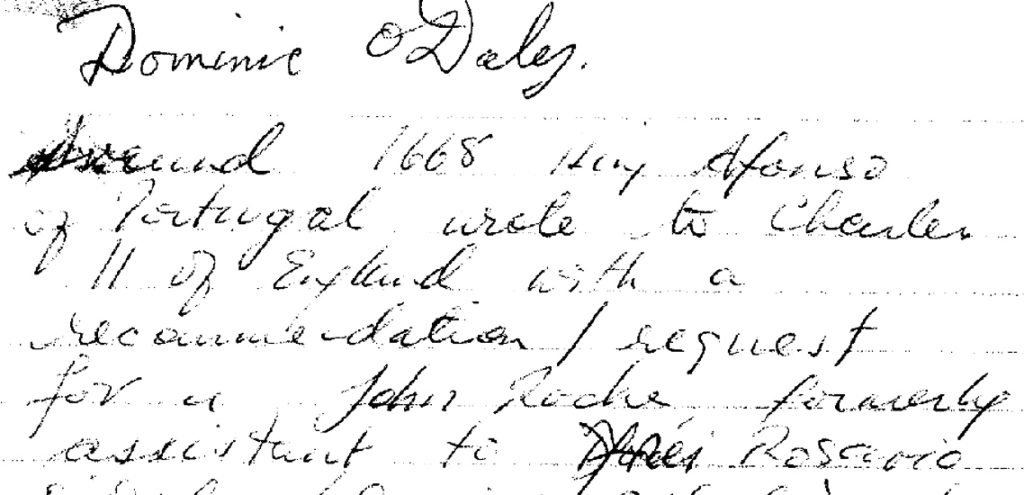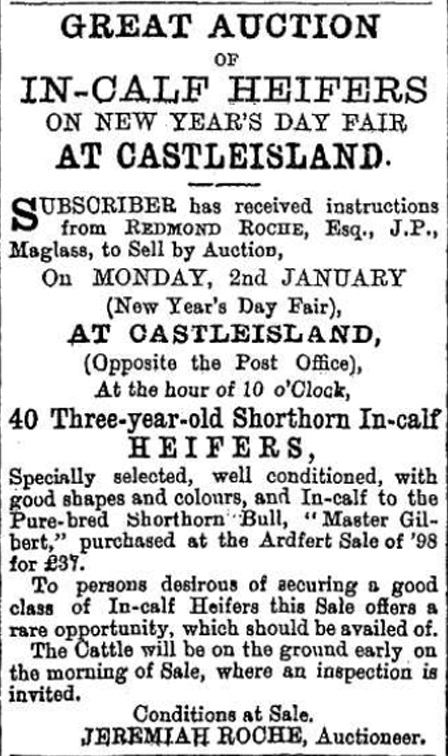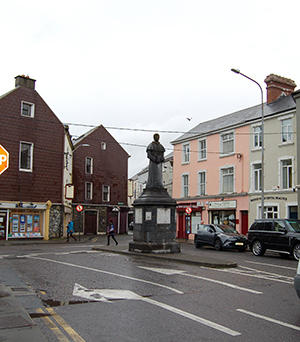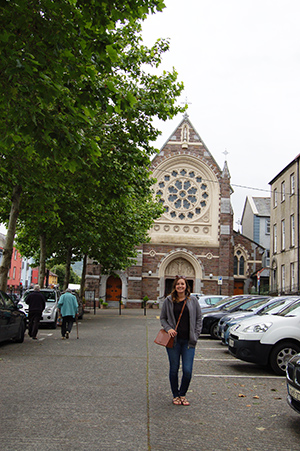A curious, handwritten document in the O’Donohoe Collection states:
Around 1668, King Afonso of Portugal wrote to Charles II of England with a recommendation for John Roche, formerly assistant to Rosario O’Daly, to be given a post in the Queen’s Bedchamber.1

Rosario O’Daly, otherwise Daniel O’Daly, whose life has recently been explored in Ambassador Extraordinaire, is said to have been born near Castleisland, long established territory of the Roche family.2
Unfortunately, the informant of the undated, handwritten document offered no clue about this particular John Roche.

Father Dominic of the Rosary
The following sketch of O’Daly was written by a nineteenth century Dominican father who placed O’Daly’s birth in Tralee:
Daniel O’Daly or, as he was better known, Father Dominic of the Rosary, was born in Tralee in the year 1595. He was descended from the ancient and noble family of the O’Dalys which had settled in Kerry early in the sixteenth century and on the maternal side from the illustrious family of the Geraldines, Earls of Desmond.
He joined the Order of Preachers at an early age, made his solemn profession in Lucca, and completed his studies at Burgos, in Old Castile. He then read a very extensive course of studies in philosophy and theology at Bordeaux in Aquitaine after which he returned to Ireland. After his return he spent some time in his native Convent of Holy Cross, Tralee, and afterwards did missionary work in other parts of the country, as a commendatory letter of the Bishop of Emly testified. 3
O’Daly went to Louvain about this time, by order of the Irish Provincial, the Very Rev Father Nicholas Lynch, S.T.M. and taught with great distinction in the college lately erected there for the Irish Members of the Order. In the year 1629, Dominic set out for Spain to arrange some matters connected with the College in Louvain. Having accomplished these matters with skill and success, and seeing that he enjoyed the favour and esteem of Philip III, King of Spain, to whom Portugal and Belgium were then subject, he formed the design of founding a convent in Lisbon for the members of the desolate and persecuted Irish Province of the Order.
Through the interest and assistance of the most illustrious and Most Reverend Don Roderico de Cunha, Archbishop of Lisbon, of the Father Master Provincial of Portugal, who was then residing at the Convent of Saint Dominic at Lisbon, of Father Master John de Vascanellos, of Father Master Alvarez de Castro, and several other influential Members of the Portuguese Province of the Order, Dominic obtained possession, before the end of the year, of a small hospital in the Rua Nova de Almada (the new street of Almada). He was joined in the work of establishing this little convent by three other Irish Dominicans, Father Peter Piercy, Father Matthew of the Cross, and Father Edward Nagle, and in a short time their numbers increased very much.
In order that the members of the community might be more easily and speedily increased, Father Dominic sent the Venerable Father Arthur MacGeoghegan to Ireland, to receive Irish youths for this convent. He was, unfortunately, seized in London and cast into prison…. He was then hanged and while yet alive cut down, his body cut into quarters and his entrails cast into the fire. He died thus gloriously about the end of the year 1633.
Owing to his martyrdom, the fame of the little convent spread more and more and immediately great numbers of young Irishmen with the natural bravery of the Irish race, and full of the love of their holy religion, flocked thither so that, in a short time, it became a Nursery of Martyrs.
Dominic saw the absolute necessity of increased accommodation.… In his difficulty he applied to the Most Serene Donna Margarita, Dowager Duchess of Mantua, Infanta of Spain and Aunt of King Philip IV and under him Regent of the Kingdom of Portugal. Dominic was her confessor and she was accustomed to come in State on the first Sunday of each month to the little Irish Dominican Convent to recite the Most Holy Rosary and walk in the Procession on that occasion.
She would have granted his petition but was prevented by her departure from Portugal in the year 1641 when the Portuguese revolted and released themselves from the power of the King of Spain. However, in the meantime Queen Lucia, wife of John IV, King of Portugal, having chosen Dominic for her confessor, he obtained such favour with this King that he sent him as ambassador to his Most Christian Majesty Louis XIV, King of France, in the year 1655.
After his return from this embassy he entreated Queen Lucia to procure the construction of a larger and more suitable convent for his Irish brethren. The Queen kindly consented to the prayers of her confessor and the foundation stone of the new building was laid on the fourth of May, 1659. The following inscription was cut on the Foundation Stone:
Her Sacred Majesty Donna Lucia de Guzman, Queen of Portugal, founded this College, dedicated to the Most Blessed Queen of the Most Holy Rosary, and the Holy Patriarch, Saint Dominic, for the Irish Dominicans, on the 4th day May, 1659.
The Convent was soon completed as there was no interruption, the entire expense having been borne by the good Queen, Donna Lucia. It was situated in the Parish of St Paul in the Square called Largo di Corpo Santo (hence the familiar name of Corpo Santo by which the Irish Dominican Convent in Lisbon is commonly known), the entire side of which it occupied, having opposite it a magnificent palace, formerly occupied by the King.
Although the convent itself was very commodious, the cloister was very small and exhibited nothing worthy of notice except the monument of the illustrious founder, Father Dominic of the Rosary (Daniel O’Daly) which was destroyed with the convent at the time of the great earthquake. The inscription was in Latin, cut in marble, and may be translated as follows:
Here lies
The Venerable Father Master
Brother Dominic of the Rosary, an Irishman,
The Founder
of this Convent, and of the Convent of Nuns of
Good Success,
Who was successful in many embassies for
Kings, Bishop-elect of Coimbra,
A man illustrious for his Prudence, Learning
and Piety.
He died on the 30th of June in the year of our
Lord 1662.
Aged 77 years.
Dominic received many honours during his lifetime …Charles II of England invited him by most affectionate and pressing letters to become confessor and spiritual adviser of his wife, Queen Catherine, daughter of John IV, King of Portugal.
And what can we say of his refusal of bishoprics? He was offered the Archiepiscopal See of Braga in Portugal and Archiepiscopal See of Goa in the East Indies, the See of Coimbra and he rejected each offer. He even refused the See of his native County of Kerry in Ireland, although offered to him under circumstances so unusual, and so honourable to himself, that few could give a refusal.
In the private archives of the Master General at Rome is the following:
The Reverend Father Dominic of the Rosary, an illustrious Professor in the University of Louvain, in Flanders, a very religious man of great discretion and mature wisdom, has been petitioned for by two bishops and one archbishop, that he may be made bishop of his native diocese of Ardfert and Aghadoe (Kerry) on account of his great prudence and zeal for religion.
Besides this petition, there was another presented by Count O’Donnell from the nobility and principal men of the diocese…. This petition was signed with the following names:
Donald O’Sullivan alias O’Sullivan More
William FitzGerald, Knight of Kerry
John O’Connor alias O’Connor Kerry
Maurice Fitzgerald, second son of the Lord of Kerry and Lixnaw
Donald M’Carthy, son of the MacCarthy More
John Fitzgerald, son and heir of the Knight of Kerry
Eugene O’Sullivan, son and heir of O’Sullivan More
Nicholas Browne, son of Sir Nicholas Browne
Eugene O’Sullivan, brother of O’Sullivan More
James Fitzgerald, Coolecosogly
John Fitzgerald, brother of the aforesaid James
The MacElligott
James FitzJohn of Liska
Henry More
Thadeus O’Donoghue alias The O’Donoghue
Doctor Ffielde, Doctor of Medicine
Edmund Hussey, MA, Professor of Law
James Dulen, MA
Thomas FitzMaurice of Ballikelly
James FitzJames of Ballymacquin
Edmund FitzThomas of Cosfole
Thomas Stacke alias Stacke of Probabstackache
Richard Coutlone of Trynstone
John Browne alias Browne of Rybrowneighe
Dermod Oge McTyrlaghe of Ballengone
John Fitz Edmund of Kilmena
Edmund Fitzmaurice alias McRobert
Patrick Fitzgerald second son of the Knight of Kerry
Maurice Fitzgerald third son of the Knight of Kerry
Edmund Here alias Here of Ballynosy
Nicholas Daule of Lisneyconyng
Gerald Deasy of Aghmore
Walter Hussey son of Edmund Hussey MA
Cornelius O’Connor heir of The O’Connor
James FitzJames of Telix
Edmund FitzMaurice of Ardglass
John Stack jnr of Killary
Thadeus J Moriarty, heir of Dermod O’Duyne
Maurice FitzJohn of Moghane
Maurice Browne of Ardolodir
Manus Shire
Nicholas Fitzgerald
Roger Shire
Maurice Roberts of Mubilly
Richard M’Elligott of Racaniny
Thomas Edmonds of Myxogahane
Edmund McUlicke of Graigenetlea
Maurice Roberts of Mubilly
Richard McDaniell alias McDaniell of Rathronge
Thomas Joye Urlye (Uxlye?)
Maurice MacEligott of Carrignefynny
This petition was also signed by the Burgesses and Catholic Inhabitants of the Cathedral Town of Ardfarty and of Trallye.
After refusing so many bishoprics through his great humility, his charity, at length, compelled him to accept that of Coimbra which he had before refused….There was, however, a deeper design concealed behind their generosity; they knew that to the Bishop of Coimbra belonged the duty of presiding over the Royal Council, which honour they wished to confer on Dominic.
‘Who would not admire,’ says the good old chronicler, ‘the wisdom and good fortune of the man who merited such a privilege from the hands of those to whom he was a foreigner?’
That he might be able, however, to assist his brethren and sisters for whom he had founded the college and convent in Lisbon, and his countrymen who were suffering persecution for the Catholic faith in Ireland, he was at length reduced through compassion towards them to be elected to the Bishopric of Coimbra but died before he received Episcopal consecration.4
_________________
1 IE MOD/C22. The document concludes: ‘Charles II’s wife was Catherine of Braganza, Princess of Portugal. Dominic O’Daly was her mother’s confessor, founder of the Irish College of Lisbon and the Dominican Convent of Lisbon, still in existence today.’ 2 Ambassador Extraordinaire: Daniel O’Daly, 1595-1662 (2017) by Margaret Mac Curtain. A recent article, ‘Friar Daniel O’Daly 1595-1662 Buried in Lisbon, Honoured in Kilsarcon’ published in The Maine Valley Post, 23 June 2018, provides a synopsis of the book. 3 The bishop’s letter in full is given in Tralee Abbey (2018) by Rev John C Ryan (reproduced by J Murphy) from which this sketch is taken. 4 Extracted from Tralee Abbey (2018) by Rev John C Ryan (reproduced by J Murphy), pp21-33.





